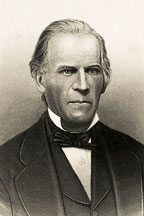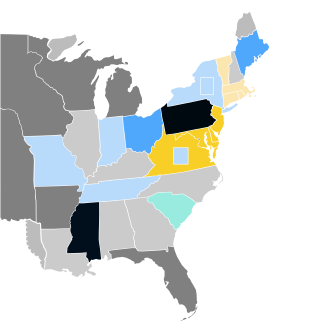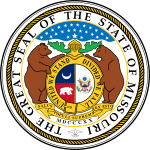The Anti-Masonic Party was the earliest third party in the United States. Formally a single-issue party, it strongly opposed Freemasonry in the United States. It was active from the late 1820s, especially in the Northeast, and later attempted to become a major party by expanding its platform to take positions on other issues. It declined quickly after 1832 as most members joined the new Whig Party; it disappeared after 1838.

Presidential elections were held in the United States from November 2 to December 5, 1832. Incumbent president Andrew Jackson, candidate of the Democratic Party, defeated Henry Clay, candidate of the National Republican Party.

Samuel Augustus Foot was the 28th Governor of Connecticut as well as a United States representative and Senator.
John Laporte was a Jacksonian member of the U.S. House of Representatives from Pennsylvania. He also was the 26th Speaker of the Pennsylvania House of Representatives.

The 1832 Democratic National Convention was held from May 21 to May 23, 1832, in Baltimore, Maryland. In the first presidential nominating convention ever held by the Democratic Party, incumbent President Andrew Jackson was nominated for a second term, while former Secretary of State Martin Van Buren was nominated for vice president.
David Spangler was an American lawyer and politician who served two terms as a U.S. Representative from Ohio from 1833 to 1837.

William Kennon Sr. was an American lawyer and politician who served three terms as a U.S. Representative from Ohio. He served in Congress from 1829 to 1833, then again from 1835 to 1837.
David C. Dickson Jr. was a state legislator, Mississippi Secretary of State, Lieutenant Governor of Mississippi and a U.S. Representative from Mississippi.

The 1833 United States Senate special election in New York was held on January 4, 1833, by the New York State Legislature to elect a U.S. Senator to represent the State of New York in the United States Senate.

The 1833 United States Senate election in New York was held on February 5, 1833, by the New York State Legislature. Interim Senator Charles E. Dudley was not put forward for re-election to a full term. Jacksonian Nathaniel P. Tallmadge was elected to succeed him after narrowly winning a Jacksonian legislative caucus over Benjamin F. Butler. He then narrowly won majorities in both houses of the legislature.

The 1836–37 United States Senate elections were held on various dates in various states. As these U.S. Senate elections were prior to the ratification of the Seventeenth Amendment in 1913, senators were chosen by state legislatures. Senators were elected over a wide range of time throughout 1836 and 1837, and a seat may have been filled months late or remained vacant due to legislative deadlock. In these elections, terms were up for the senators in Class 3.

The 1832–33 United States Senate elections were held on various dates in various states. As these U.S. Senate elections were prior to the ratification of the Seventeenth Amendment in 1913, senators were chosen by state legislatures. Senators were elected over a wide range of time throughout 1832 and 1833, and a seat may have been filled months late or remained vacant due to legislative deadlock. In these elections, terms were up for the senators in Class 1.

The 1826–27 United States Senate elections were held on various dates in various states. As these U.S. Senate elections were prior to the ratification of the Seventeenth Amendment in 1913, senators were chosen by state legislatures. Senators were elected over a wide range of time throughout 1826 and 1827, and a seat may have been filled months late or remained vacant due to legislative deadlock. In these elections, terms were up for the senators in Class 1.

The 1832 United States presidential election in Pennsylvania took place between November 2 and December 5, 1832, as part of the 1832 United States presidential election. Voters chose 30 representatives, or electors to the electoral college, who voted for president and vice president.

The 1832 United States presidential election in New York took place between November 2 and December 5, 1832, as part of the 1832 United States presidential election. Voters chose 42 representatives, or electors to the electoral college, who voted for president and vice president.

The 1832 United States presidential election in Ohio took place between November 2 and December 5, 1832, as part of the 1832 United States presidential election. Voters chose 21 representatives, or electors to the Electoral College, who voted for President and Vice President.

The 1831 Alabama gubernatorial election was an election held on August 1, 1831, to elect the governor of Alabama. Jacksonian candidate John Gayle beat the incumbent Jacksonian governor Samuel B. Moore and National Republican candidate Nicholas Davis with 55.01% of the vote.

The 1832 Connecticut gubernatorial election was held on April 13, 1832. Incumbent governor and National Republican nominee John S. Peters was re-elected, defeating former senator and Democratic nominee Calvin Willey with 71.44% of the vote.

The 1831 Vermont gubernatorial election took place in September and October, and resulted in the election of William A. Palmer to a one-year term as governor.

The 1828 Indiana gubernatorial election took place on August 4, 1828 under the provisions of the Constitution of Indiana. It was the fifth gubernatorial election in the State of Indiana. James B. Ray, the incumbent governor, was re-elected, defeating Israel T. Canby, the former state senator representing Jefferson and Jennings counties, and Harbin H. Moore, the outgoing speaker of the Indiana House of Representatives, in a three-way race. The election took place concurrently with races for lieutenant governor and members of the Indiana General Assembly.


















